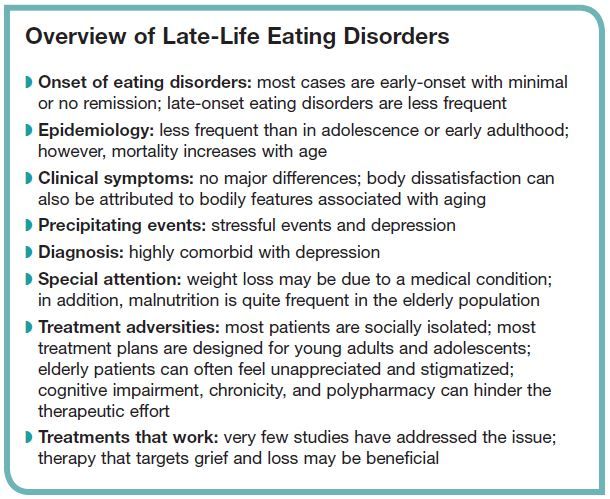Publication
Article
Psychiatric Times
Eating Disorders in Late Life: Implications for Clinicians
Author(s):
There are a considerable number of aging patients with an eating disorder who have only partial symptom remission or who remain ill for many decades. Here is a case in point.
Late-Life Eating Disorders

Eating disorders, especially anorexia nervosa, have traditionally been considered an illness of the young, and their etiologies have been linked to the stress of the transition from childhood to adolescence and adulthood. The literature on eating disorders in the elderly is sparse, with only a few studies and case reports published during the past decades. There are a considerable number of aging patients with an eating disorder who have only partial symptom remission or who remain ill for many decades. Moreover, although quite infrequent, there are cases of “tardive” eating disorders that manifest in middle age or late in life.1
CASE VIGNETTE
Mrs K is 68 years old, married with 2 children and 3 grandchildren. She has suffered from binge eating disorder and obesity since her early 30s. During her first visit, she confesses that the main reason for her decision to return to treatment was that because of the disorder, she is constantly gaining weight and losing her ability to act independently.
During her 40s and 50s, she had had 10 years of group psychodynamic psychotherapy and 5 years of individual psychodynamic-oriented psychotherapy that helped her with her marital problems but not with the binge eating disorder. She says, “I know that I am old and you are probably thinking that nothing can be done with me, but I think I deserve another chance to try to get well. I do not want to just accept my condi-tion. I want to deal with it.”
As illustrated in this brief case vignette, eating disorders not only exist in late life, but there is also a legitimate demand from the patients to get the best possible treatment rather than just palliative care.
Epidemiological data
Most of the studies conducted in populations of elderly women found that eating disorders were far less frequent in late life than in adolescence or early adulthood. Gadalla2 found that symptoms of disordered eating were present in 2.6% of women aged 50 to 64 years and in 1.8% of women aged 65 years or older. Disordered eating symptomatology was positively associated with stress level and negatively associated with physical health.
The British National Psychiatric Morbidity Survey showed that rates of eating disorders were 4.3%, 2.1%, and 1.1% in those aged 50 to 59, 60 to 69, and 70 or older, respectively.3 Mortality from eating disorders, and specifically from anorexia nervosa, in the elderly was found to be quite high: 10% in the 55 to 64 age-group, 12% in the 65 to 74 age-group, and 28% in the 85 and older group.4
Clinical symptoms
In an early report on eating disorders in late life, Hsu and Zimmer5 found that the symptoms of anorexia nervosa and bulimia nervosa in the elderly closely resemble those in younger patients. Findings indicate that overall body dissatisfaction is somewhat stable across the life span.5-8 A community study of 60- to 70-year-old women found that 60% of the participants were dissatisfied with their bodies and 80% practiced some form of weight control.8 An increased level of body dissatisfaction was associated with higher BMI in mid-life and in older women.7 It should be noted that body dissatisfaction in both men and women in late life is attributed to the aging process (eg, wrinkles, hair loss, muscular atrophy).
Stressful life events and depression seem to be the most common precipitating events in late-onset eating disorders.9,10 In a study by Lapid and colleagues,1 54% of the patients reported that some kind of stressful events had occurred before the development of the eating disorder. The most frequent precipitating stressful events were widowhood and bereavement (42%), medical illnesses (23%), marriage-related difficulties (19%), and children-related issues (15%).
The perpetuating factors of late-life anorexia nervosa may include relief from social and domestic responsibilities, control over others, and reduced social involvement.9-12 Older adults with eating disorders may use disordered eating as a mechanism to regain power that has been lost as a result of aging.1,12 For some patients, eating disorders are a way of gaining control over loved ones through protest and by drawing attention to the discontent they feel for their current circumstances. It may even be that in the elderly, eating disorders are a method of indirect suicide.1,12
Comorbidities
While the eating disorder symptoms in the elderly are similar to those of younger individuals, diagnosis of eating disorders can be difficult in a complex geriatric patient. Eating disorders in older women are highly comorbid with affective and anxiety disorders. Scholtz and colleagues13 found that eating disorders in women older than 50 years were comorbid with depression (46%), anxiety disorders (31%), alcohol dependency syndrome (19%), and personality disorder (19%). The most common comorbid psychiatric disorder in elderly patients with eating disorders is MDD, which can be present in up to 69% of patients.1
Women older than 50 who have an eating disorder often report comorbid medical conditions that are related to aging and a prolonged eating disorder.13 The most frequently reported comorbidities are osteoporosis (38%) and GI problems (17%).5
Differential diagnosis
In elderly patients, weight loss is often attributed to a known medical condition and/or its pharmacological treatment or to a psychiatric condition such as depression.1 Moreover, malnutrition is common in the elderly, especially in medical inpatients, with an estimated prevalence between 17% and 65%.14 Many physical and social factors that are associated with old age make the elderly person nutritionally vulnerable, including social isolation, poverty, reduced mobility, decreased GI reserve, and impaired taste sensation.
Social isolation
The management and treatment of eating disorders in late life present a number of adversities that the clinician has to take into consideration. Most of the elderly patients with early-onset eating disorders live alone, with very few and often distant social relations. If they have been able to create a family of their own, spouses or children are often the primary caregivers-which may be challenging and sometimes exhausting.1 However, nearly half of elderly patients who have an eating disorder are not in a relationship.13 Moreover, these patients have limited contact with friends and/or extended family and limited time devoted to leisure activities.
Stigmatization
Elderly patients with an eating disorder suffer double stigmatization: the disorder itself is highly stigmatized, and because it is considered a disorder of the young, further stigmatization is endured because of advanced age. Many patients report that the first reaction of the clinician is often disbelief and frustration. “You are too old to have an eating disorder” or “you are too old to be treated for an eating disorder” are quite often the responses to their plea for help. Web sites are also seen as unhelpful because they are focused solely on younger patients.1
Treatments that work?
Treatments that were regarded as beneficial by elderly patients with an eating disorder included group therapy, couple therapy, practical support, and inpatient care on medical wards.1 A study conducted in inpatient middle-aged women found that older women gained more benefit from therapy targeting grief and loss than did younger patients.15
The role of pharmacotherapy is limited and should be used with caution. Most older patients take multiple medications for medical conditions, and the use of psychotropics may lead to adverse effects or drug interactions.1 Dementia or symptoms of dementia are common in the elderly and can limit the effectiveness of some psychotherapeutic strategies, such as cognitive-behavioral therapy. Consider a variety of medical, psychological, and social factors that can influence the effectiveness of the treatment strategies to propose to the patient a suitably adjusted treatment plan.
Conclusions
As illustrated in the following case vignette, eating disorders in late life can frequently be unrecognized or masked behind medical conditions, depression, or the natural changes of aging. Early recognition and proper treatment of eating disorders in the elderly are essential to reduce the psychosocial and medical impact of the disorder and improve the patient’s quality of life.
CASE VIGNETTE
An 18-year-old patient with anorexia nervosa wrote about her grandmother: “Ever since I remember her, she was very thin. She was always dieting, avoiding certain foods, not eating in social situations. On several occasions, I saw her chewing and spitting out foods that she did not allow anyone else in her family to eat. I understand that she was ill, but I cannot forgive her for persuading my mother to forbid me to eat a proper amount of food for my age. I see now in my grandmother all the signs of anorexia that the rest of my family is not willing to admit. I do not blame her, I just do not want to grow old and be afraid, as she is, to eat a bowl of ice cream.”
Disclosures:
Dr Gonidakis is a Lecturer of Psychiatry and Ms Karapavlou is a psychology PhD candidate in the Eating Disorders Unit, 1st department of psychiatry of the Athens University Medical School in Greece. They report no conflicts of interest concerning the subject matter of this article.
References:
1. Lapid MI, Prom MC, Burton MC, et al. Eating disorders in the elderly. Int Psychogeriatr. 2010;22:523-536.
2. Gadalla TM. Eating disorders and associated psychiatric comorbidity in elderly Canadian women. Arch Womens Ment Health. 2008;11:357-362.
3. Ng IS, Cheung KC, Chou KL. Correlates of eating disorder in middle-aged and older adults: evidence from the 2007 British National Psychiatric Morbidity Survey. J Aging Health. 2013;25:1106-1120.
4. Hewitt PL, Coren S, Steel GD. Death from anorexia nervosa: age span and sex differences. Aging Ment Health. 2001;5:41-46.
5. Hsu L, Zimmer B. Eating disorders in old age. Int J Eat Disord. 1988;7:133-138.
6. Webster J, Tiggemann M. The relationship between women’s body satisfaction and self-image across the life span: the role of cognitive control. J Genet Psychol. 2003;164:241-252.
7. Gagne DA, Von Holle A, Brownley KA, et al. Eating disorder symptoms and weight and shape concerns in a large web-based convenience sample of women ages 50 and above: results of the Gender and Body Image (GABI) study. Int J Eat Disord. 2012;45:832-844.
8. Mangweth-Matzek B, Rupp CI, Hausmann A, et al. Never too old for eating disorders or body dissatisfaction: a community study of elderly women [published correction appears in Int J Eat Disord. 2007;40:193]. Int J Eat Disord. 2006;39:583-586.
9. Dally P. Anorexia tardive-late onset marital anorexia nervosa. J Psychosom Res. 1984;28:423-428.
10. Gonidakis F, Georgantopoulos G, Konstantakopoulos G, Varsou E. Late onset anorexia nervosa and the role of parental family: presentation of two cases. Eat Weight Disord. 2014;19:409-412.
11. Nicholson SD, Ballance E. Anorexia nervosa in later life: an overview. Hosp Med. 1998;59:268-272.
12. Harris M, Cumella EJ. Eating disorders across the life span. J Psychosoc Nurs Ment Health Serv. 2006;44:20-26.
13. Scholtz S, Hill LS, Lacey H. Eating disorders in older women: does late onset anorexia nervosa exist? Int J Eat Disord. 2010;43:393-397.
14. Clarke DM, Wahlqvist ML, Rassias CR, Strauss BJ. Psychological factors in nutritional disorders of the elderly: part of the spectrum of eating disorders. Int J Eat Disord. 1999;25:345-348.
15. Forman M, Davis WN. Characteristics of middle-aged women in inpatient treatment for eating disorders. Eat Disord. 2005;13:231-243.




